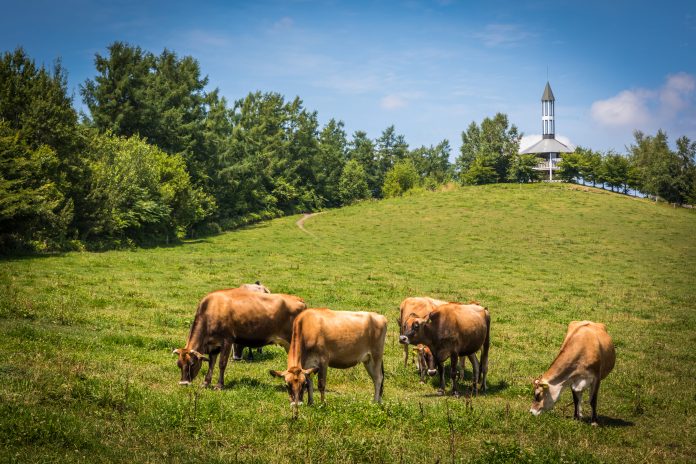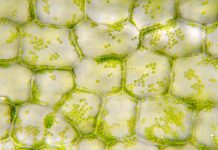Dr Yuri Yamazaki from the Faculty of Regional Environmental Science at Tokyo University of Agriculture, describes encountering cows in forests and urges us to think about the sustainable future of livestock
Walking in the woods where birds and insects tweet, I can hear the sound of stepping on the forest floor and deep breaths. I can see the cattle’s black bodies calm and relaxed, avoiding the hot summer sun. Forest and cows. Inter-forest grazing, where cattle are released into the forest, maybe a hint for the sustainable livestock farming.
Sustainable livestock farming
Before we talk about forest grazing, let’s first discuss sustainable livestock farming.
At present, the challenges of achieving sustainable livestock production in Japan can be broadly divided into three categories: self-sufficiency rate, an environmental problem, and animal welfare.
The self-sufficiency rate of livestock products in Japan is 62% on a calorie basis, but considering the feed self-sufficiency rate, the self-sufficiency rate of livestock products drops to 16%. The feed self-sufficiency rate, which is a combination of roughage and concentrated feed, is 25%, and only 10% can be self-sufficient with concentrated feed. As a result, Japan’s livestock industry has a high ratio of feed costs to production costs, and fluctuations in exchange rates and grain processes have a significant impact on livestock management.
Regarding environmental problems in the livestock industry, the treatment of livestock waste is the main issue. Livestock waste is generally composted and returned to farmland. However, due to the limited farmland area in Japan, improper processing such as field loading is performed, which is considered to be the cause of the bad smell and water pollution.
Internationally, the animal welfare of livestock is emphasised, and consideration for the environment for raising livestock is evaluated as a brand of livestock food. However, animal welfare in Japan mainly targets pet animals, and animal welfare for livestock has not been popularised or established.
For example, Japanese beef “WAGYU” is marinated in Japan and is highly evaluated overseas. 90% of Japanese beef is a breed called “Japanese Black”. Most of the fattening of Japanese Black is carried out in a barn, and a large amount of concentrated feed is supplied. Grazing is performed to make the body larger in the rearing stage, but exercise is suppressed as much as possible to soften the meat quality in the latter stage of fattening. Japanese beef is rated according to the “Beef Carcass Trading Standards” established by the Japan Meat Grading Association, and this grade has a significant influence on price and sales. Since this rating highly evaluates meat with a high degree of marbling, the method of raising Japanese Black, which is prone to marbling, is widely adopted in a barn.
In other words, the current methods for fattening Japanese Black, (1) depend on the import of concentrated feed, (2) the livestock waste cannot be circulated within the area due to the use of cowshed and (3) from the viewpoint of animal welfare, it cannot be said that the breeding environment considers the health of cattle.
One of the methods that can solve these problems is “livestock grazing”.
Forest grazing
In Japan, where more than 70% of the land is forested, inter-forest grazing has been performed for a long time, combining labour-saving in forest raising work with low-cost beef production. Many merits and demerits of forest-grazing have been discussed from the livestock and forestry perspectives, and in recent years, it has also been appreciated when it comes to animal welfare. In particular, with the emphasis on ensuring food safety and security and increasing awareness of health, the demand for healthy livestock production by grazing will inevitably increase in the future. Although there are few cases of assessing the environmental impact of livestock grazing, it is reported that adjusting the number of grazing heads and the grazing period is useful in regenerating grassland biota in natural grasslands. It can also be expected as one of the methods for the conservation and management of ecosystems. However, compared to the fact that organic farming and crop production without pesticides are branded and widely recognised all over the country, the name recognition and prevalence of grazing livestock in Japan are low. It is considered that one of the reasons for this is that there are few survey reports on the harmful effects and ethical effects of grazing and livestock on the environment.
On the farm I am investigating, beef cattle are grazing day and night in approximately 100 ha of grass and forests. The river that passes through the grazing land is once stored in a dam located downstream of the ranch, flows into the city, and then flows out into the Pacific Ocean. Some areas around the farm are conserved as water source recharge forests in the area, so there is concern about the effect of grazing on river water quality. From the previous studies, the ion concentration in the river water flowing through the ranch showed a slight increase in nitrogen concentration. Still, overall there was no significant difference with the water quality in the mountain stream area, and the effect on the downstream area was minimal.
We are also conducting a behavioural survey of cattle using a sensor camera. GPS is often used to investigate the behaviour of livestock. Still, in the case of grazing, there are very few opportunities to come into direct contact with grazing cattle, which not only makes GPS management difficult but also stresses the behaviour of cattle. Therefore, we set up multiple sensor cameras used for research on wild animals in the ranch to verify the movement route and behaviour of cattle. As a result, it was found that the cows moved in the north and south of the farm in about a month. From this, repeated movements within the farm led to the prevention of excessive accumulation of livestock excrement.
Also, many Sika deer, northern foxes, brown bears, and other wild animals were spotted around the pasture, suggesting that forest grazing may have multiple ecosystem service functions. For example, there is a possibility that it will have functions in forest grazings such as food supply by meat production (supply service), appropriate forest management, water purification/soil erosion control by maintaining livestock density (regulation service), maintenance of semi-natural grassland as grazing land, provision of habitat (basic service), and maintenance of natural landscape (social service). The relationship in which one ecosystem service improves in response to another ecosystem service improvement is called synergy, and the relationship in which one ecosystem service improvement reduces another ecosystem service is called a trade-off. It is speculated that the management method of grazing land and forest, including the number of livestock and the density of livestock, has a significant influence on whether the ecosystem services in forest grazing have a trade-off relationship or a synergistic relationship.
Towards the development of sustainable agriculture
Since grazing livestock is expected to be used in mountainous areas, abandoned cultivated land, and forest management, its widespread use is recommended in terms of agriculture and national land conservation. However, there are very few concrete examples of research on positive effects on the environment. Establishing a grazing management method for quantitatively assessing the positive and negative environmental impacts of grazing livestock and improving synergies between ecosystem services is a significant challenge towards the development of sustainable agriculture.
Please note: This is a commercial profile











